
UNITED STATES SWIM SCHOOL ASSOCIATION




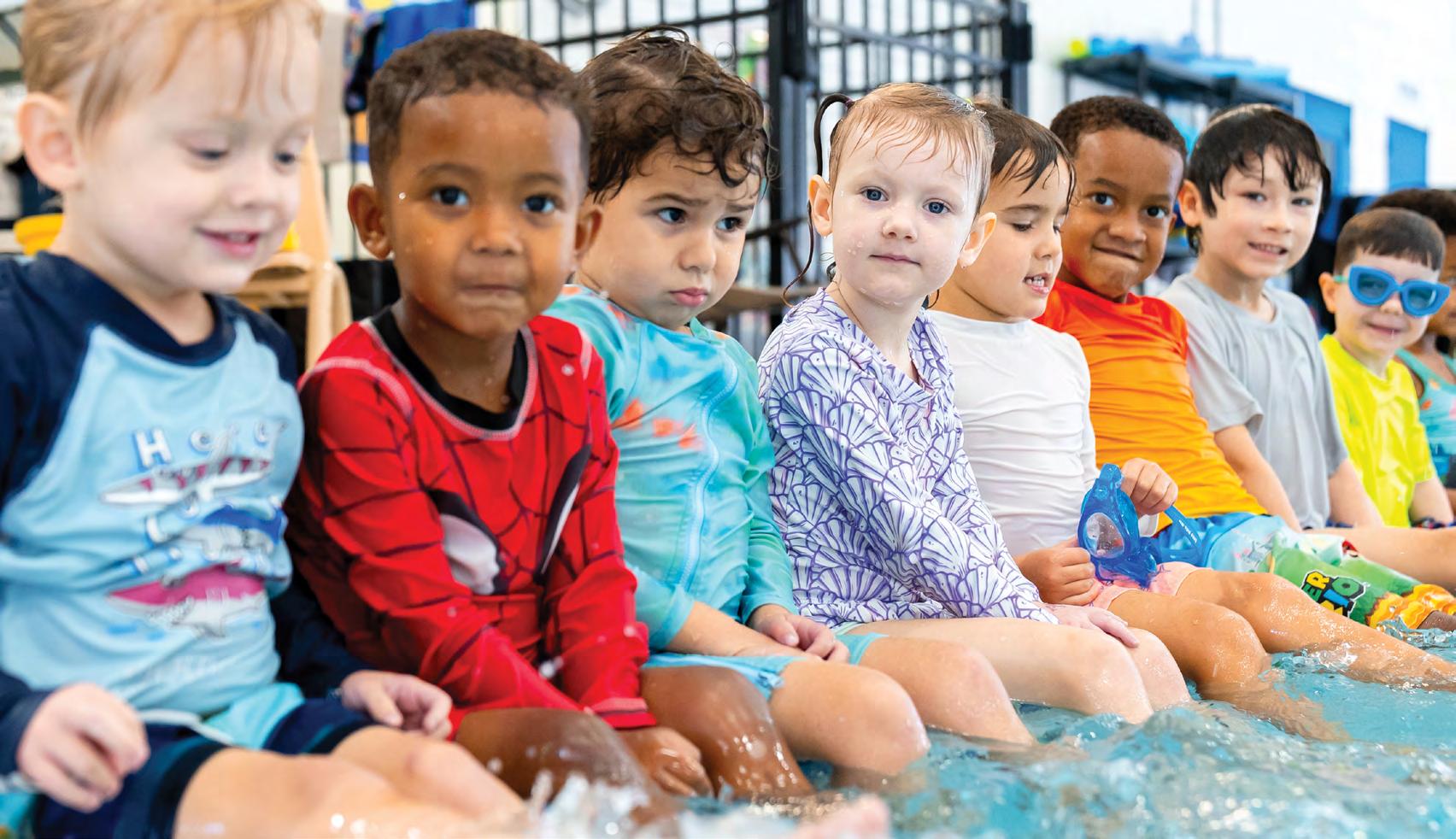


UNITED STATES SWIM SCHOOL ASSOCIATION





ASSOCIATION HEADQUARTERS
4815 E. Carefree Hwy., Suite 108-480 Cave Creek, AZ 85331
480.837.5525 usssa@usswimschools.org usswimschools.org
Executive Director
Lisa M. Zarda, CAE, CNAP
Editor
Jessica Zimmer
ASSOCIATION OFFICERS
President
Rose Cholewinski, SwimAmerica – Davis
Vice President
Micha Seal, Watermelon Swim
Treasurer
Debbie Sayers, DolFUN SWIM Academy
ASSOCIATION DIRECTORS
Lori Klatt America’s Kids Swim School
Melissa McGarvey British Swim School
Brittany Moog Bitty Bubbles Swim School
Susie Van Ekeren Wisconsin Swim Academy

The “casual” atmosphere sets the tone, but professionalism sets the standard.
Ahhh, the professional side of a loving, beautiful, energetic, joyful, “casual” industry. We are given a special place to share life and water safety skills while wearing flip flops, a swimsuit, a smile and an awesome t-shirt.
But “casual”, in our swim community also means professional. Being professional is not defined by what we wear but by how we show up. While we may look “casual”, our work demands discipline, attention, consistency, love and respect. Parents place their trust in us every time they bring their children through our doors. That trust comes with a responsibility to model integrity and reliability. Whether it’s showing up on time, having contagious energy, maintaining a safe environment, returning a phone call, or honoring a commitment to a family. Showing up with our best foot forward helps create trust and credibility.
The way we communicate is another reflection of professionalism. Words matter, especially in the environments we create for children and families. Professional communication means choosing language that is age appropriate, reassures, informs, and encourages. It means remembering that simple courtesies like “please” and “thank you” aren’t just niceties. They are words that convey respect for parents, children, grandmas, grandpas, vendors and colleagues alike. In many ways, the calm, respectful, and clear way we communicate sets the tone for how others experience our swim schools. Don’t get me wrong….I have had my share of “oops” comments where the words are flowing out of my mouth and I want to retrieve them but it’s too late. I have learned that owning it and apologizing for the mistake goes a long way. Words matter. Choose your words carefully.
And, of course, I can’t talk about professionalism without talking about safety. At the core of everything we do is safety. Safety isn’t just part of our operations…it’s at the heart of every decision, every conversation, every lesson taught. Professionalism, for all of us, is never compromising on that commitment. Every choice, from the way we train instructors to how we design lessons, must reflect our dedication to safety. Families trust us not only to teach their children a skill, but to protect their child and keep them safer in the process.
I love working in a casual environment where I show up, in shorts, a smile and an awesome t-shirt, to make a difference, with love and to do good in our world, every single day.


ROSE CHOLEWINSKI President US Swim School Association






Professionalism is the foundation of our industry.
As leaders, instructors, and advocates for water safety, the way we present ourselves, the standards we uphold, and the training we invest in all shape how the public views swim instruction. At the United States Swim School Association, we are committed to elevating not only the safety and quality of instruction but also the professionalism of everyone representing our members.
One of the most significant steps forward in this effort is the USSSA Certified Fundamental Swim Instructor (CFSI) designation. This certification is more than just a credential—it is a commitment to excellence. By pursuing the CFSI, instructors demonstrate their dedication to best practices, continuing education, and the highest standards of care in our industry. Parents and caregivers trust you and the CFSI helps reinforce that trust by ensuring every certified instructor is equipped with essential skills, knowledge, and professionalism.
The impact of this program is already being felt across our community. As Tracy Koleber, owner of Nitro Swimming, shared, “Nitro Swimming was a proud early adopter of the USSSA’s CFSI course. The course bolsters the Nitro training our staff was already receiving, plus it gives us credibility with parents and government entities because it is an outside certification by a national organization.”
Her words capture exactly what we envisioned when creating the CFSI, a certification that not only strengthens in-house training but also elevates the perception of our industry with families and stakeholders alike.
The CFSI also serves a broader purpose: it strengthens our collective voice as an industry. When swim schools across the country share a common standard of professionalism, we not only improve instruction in individual pools but also elevate the perception of the swim school profession as a whole. This unity gives us the ability to set benchmarks, advocate for water safety more effectively, and lead the way in shaping the future of learn-to-swim education.
I encourage every member school to embrace the CFSI as part of your culture of professionalism. Support your instructors in achieving this certification, and celebrate it as a milestone of growth and commitment. Together, we can ensure that our association continues to be recognized as a leader in professionalism, safety, and excellence.
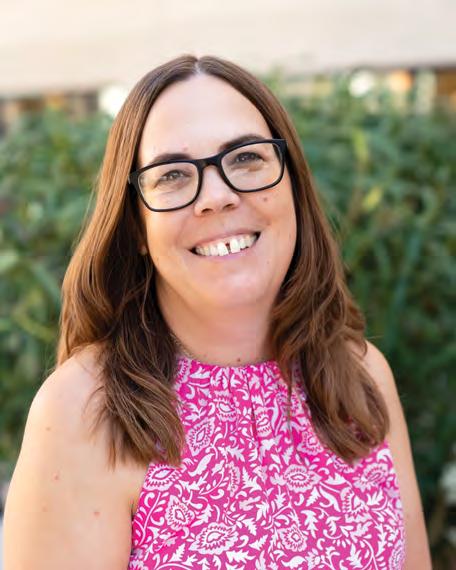
LISA M. ZARDA, CAE, CNAP Executive Director US Swim School Association


In Phoenix, the 2025 USSSA National Conference brought our community together for three unforgettable days of growth, connection, and celebration. Each session, conversation, and shared laugh reminded us why we do what we do and how much stronger we are together. Here’s a look back at the moments that defined it.
“This conference continues to be one of the best opportunities for connection and collaboration in our industry.”
“This event is a must for any SwimSchoolers looking to get ahead. Great content and fabulous networking.”
“What a way to kick off the event! That was incredible!”
On Hoop Dance performance by Sinquah Productions
“She was fantastic! I loved the message and energy. We’re all about positive vibes, it was nice to put words to actions and mindsets.”
On The Energy Bus Workshop: Turning Positivity into Action with Maricarmen Saleta
“I really liked that is was a more heavily guided round table. Speaker was good and definitely wouldn’t mind having them lead something similar again.”
On Fixing the Broken Windows: How to Fix Small Issues Before They Become Bigger Problems with Brenna Dowd
“Really fun engaging way to wrap conference – excited to bring it home to our team”
On Personality Workshop: Creating an Environment for Exceptional Communication Between Leaders and Their Teams with Kelly Martinez
“The presentation was so lively and fun! It definitely brought attention to new ways to obtain funding through grants.”
On Secure The Bag: Secrets to Secure Funding to Scale Your Business with Paulana Lamonier
“Very amazing science based information.”
On Engagement Strategies in Aquatic Education: Regulation and Redirection with Sue Mayo
Continued on next page...

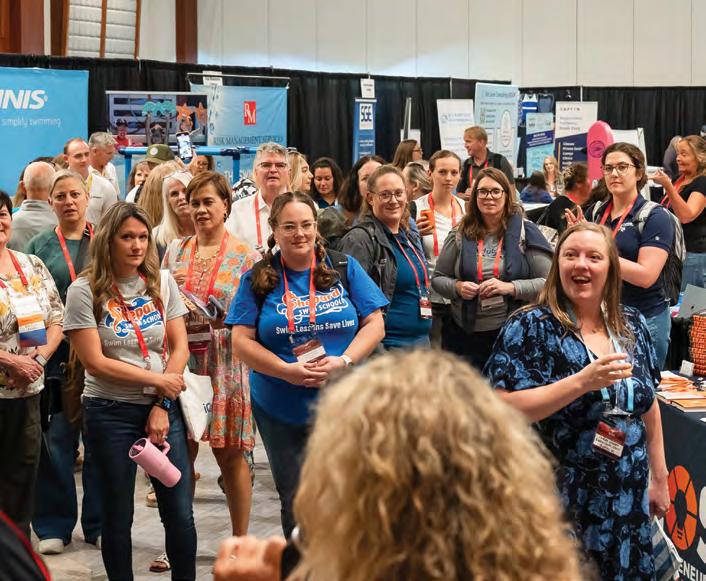

“As always, she knocked it out of the park. With some old ideas repackaged in new ways that made you consider your options, as well as plenty of brand new ideas. Tons of actionable takeaways! Loved every minute.”
On The ROI of Building an OWN IT Culture in your Business with Miren Oca
“This has been my favorite so far! I’ve learned the most to bring back to our school from this session!”
On Engagement Strategies in Aquatic Education with Sue Mayo
“I am so appreciative of the USSSA conferences. I have learned so much over the years. Thank you!”
“Loved the venue! Food was amazing. T-shirt idea was fantastic!”
“Loved the donkey!”
“I have LOVED the growth of this conference over the years and cannot wait to see how everyone continues to innovate for years to come!”
WE CAN’T WAIT TO KEEP ELEVATING AQUATIC EDUCATION TOGETHER IN ORLANDO, FLORIDA, OCTOBER 19–21, 2026!

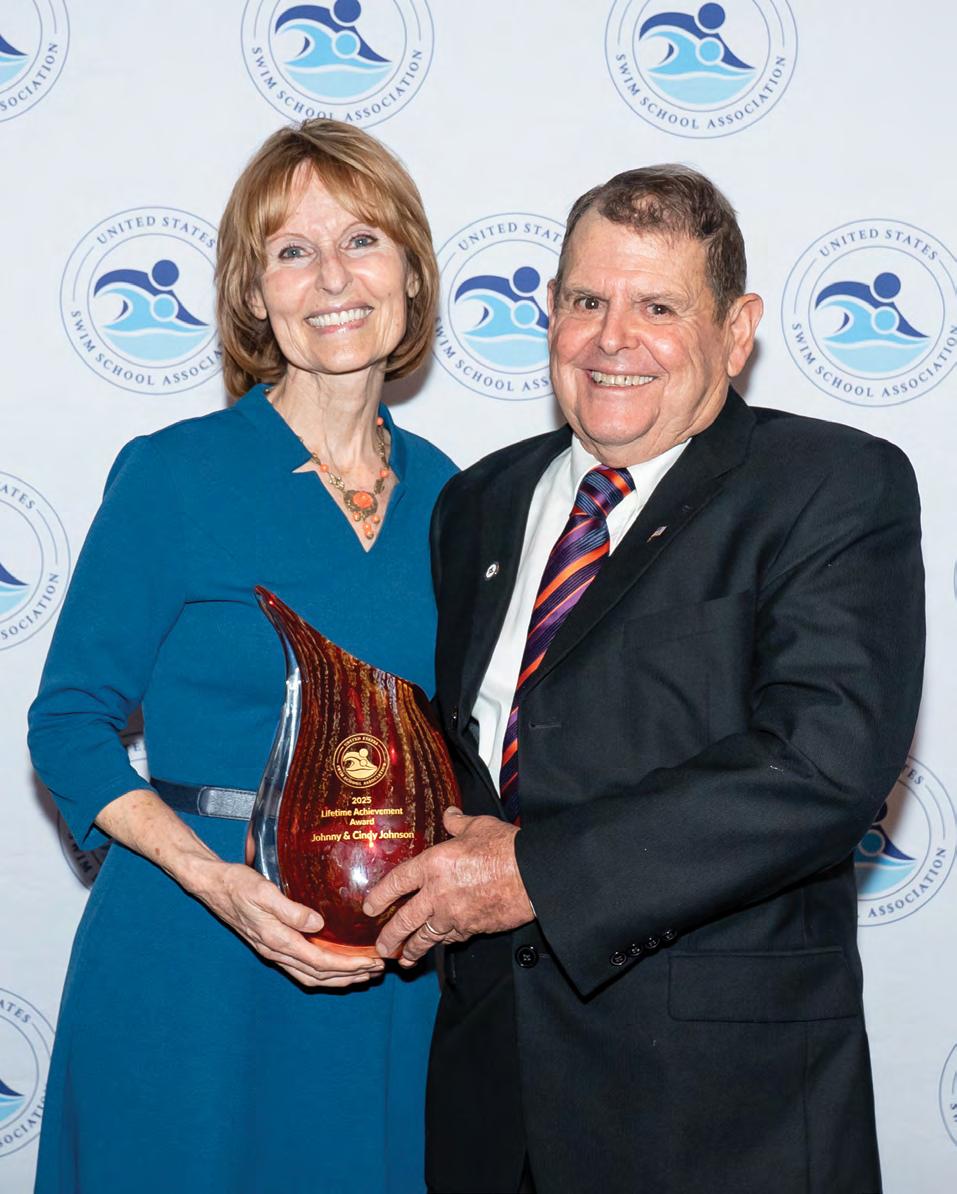



ED MCHALE INSTRUCTOR OF THE YEAR
DEB PAPARELLI-RIVERO
Hubbard Family Swim School

ED MCHALE INSTRUCTOR OF THE YEAR
MACIE BARNETT
Swim America-Davis

GUIDING LIGHT
LORI WEBER
Lori’s H2O Skills
RISING STAR
BRITTANY MOOG
Bitty Bubbles Swim School
2025 CORE VALUE RECOGNITIONS
Building & Strengthening
Relationships
KAILA MIELKE
Wisconsin Swim Academy
JACQUIE FERNEAU
Deep Blue Swim School
KRISSY BARTLETT
SwimKids Swim School
CRYSTAL PETROVICH
British Swim School
Professionalism
SVETLANA MINAKOFF
British Swim School
LORI KLATT
America Kids Swim School
CARRIE DEMONT
DeMont Family Swim School
SARAH BURKE
British Swim School
Safety First and Always
TAMMY ANDERSON
Aqua Pros Swim School
PAULANA LAMONIER
Black People Will Swim
SHILOH HURST
Vista Swim Academy
Lifelong Learners
MIGUEL CERVANTES
Academy Swim Club
SHANNON SCHAFER
Inclusion Sports
TERENCE O’MALLEY
AnT Swim School
TRISH MILLER
SwemSchool
2025 SOCIAL BUTTERFLY AWARD
LULU CISNEROS















ORIGINALS: HOW NON-CONFORMISTS MOVE THE WORLD
ADAM GRANT
Grant digs into how innovators challenge the status quo, generate creative ideas, and bring them to life. He shares stories of entrepreneurs, activists, and everyday people who made bold moves without being reckless.
Why it’s a great read: It encourages calculated risk-taking and helps you nurture creativity in yourself and others— a must-read for anyone looking to do meaningful, innovative work.

THE PERSONAL MBA: MASTER THE ART OF BUSINESS
JOSH KAUFMAN
This no-fluff business book breaks down essential business concepts— marketing, sales, finance, productivity— without the cost or time commitment of a traditional MBA.
Why it’s a great read: It’s practical, readable, and endlessly applicable. Whether you’re a founder, manager, or curious learner, you’ll walk away with a stronger grasp of how business works.

DEEP WORK: RULES FOR FOCUSED SUCCESS IN A DISTRACTED WORLD
CAL NEWPORT
Newport argues that the ability to focus without distraction is a superpower in today’s world. He outlines how to cultivate deep, meaningful work and eliminate the constant noise of digital life.
Why it’s a great read: If your attention feels fragmented or your productivity is suffering, Deep Work offers a path to regain your focus and do more meaningful work.
Continued on next page...

CAROL S. DWECK
This book introduces the idea of fixed vs. growth mindsets and how these attitudes shape our success in school, business, sports, and life. It’s backed by decades of psychological research.
Why it’s a great read: It’s foundational for anyone committed to lifelong learning. You’ll gain insight into how to foster resilience, embrace challenges, and keep growing—no matter your starting point.
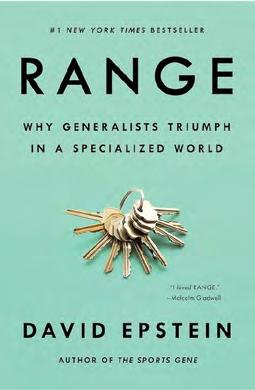
DAVID EPSTEIN
Epstein makes the case for generalists— those with wide-ranging interests and diverse experiences—by showing how they often outperform specialists in complex, unpredictable environments.
Why it’s a great read: It’s a confidence boost for curious minds who don’t fit into one lane. If you’ve ever felt “too scattered,” this book will show you how breadth can be a competitive advantage.

ANGELA DUCKWORTH

Duckworth’s research shows that success is more about stamina than talent. Through interviews and studies, she unpacks how persistence and passion fuel long-term achievement.
Why it’s a great read: It’s inspiring and backed by science. Grit is essential for anyone chasing big goals over time— especially when the journey gets hard.

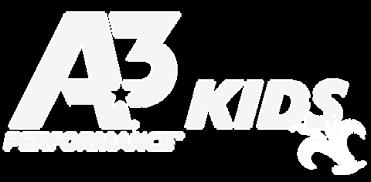










BY SVETLANA MINAKOFF BRITISH SWIM SCHOOL MANHATTAN
For nearly two decades, my life revolved around the world of technology. I earned my degree in software engineering and dedicated my career to large-scale projects in the corporate sector. One of the most meaningful experiences of my professional life was working on New York City’s wireless network buildout after September 11 — a long-term project that reinforced the importance of resilience and innovation. I was proud to contribute to a defense company’s work during such a pivotal time for our city.
But like so many of us, my life shifted dramatically during COVID-19. The world of remote work became the norm, and my role as a mother of two boys took center stage. Our family has always been deeply connected to the water. My husband, a former Ukrainian water polo champion and professional swimmer, passed his passion for swimming on to our children, who became competitive swimmers at an early age. Swimming wasn’t just an activity in our household — it was part of our identity.
When the pandemic shut everything down, including pools, we were devastated. Practices stopped, routines ended, and suddenly the one sport that defined our family was no longer accessible. We didn’t know when or how our boys would swim again.
Then came an unexpected twist. One afternoon, I stepped out of my apartment and saw my neighbor’s son carrying a towel and goggles. I asked where he was headed, and his mom shared that he was going to swim class at a school in Bayonne, New Jersey — one of the few places still open during those uncertain times. That school was British Swim School.
I didn’t hesitate. The very next day, I enrolled my youngest son, who was five years old at the time, and brought him for an evaluation. Despite being a competitive swimmer, he froze when faced with new people and a new instructor. The instructor, who happened to be an incredible teacher with one leg, was inspiring — but my son couldn’t show the skills he had worked so hard to develop.
Continued on next page...
The deck ambassador assessed him and confidently told me my child wasn’t a competitive swimmer, but instead belonged in the beginner “Starfish” program. I was even told that perhaps I, as his mother, was in denial.
I knew better. I pulled my son aside and said, “If you don’t show them your strokes, you’ll be swimming with the babies.” Something clicked in that moment. Without hesitation, he dove in and swam butterfly, freestyle, and backstroke with ease. The staff watched in disbelief as my son displayed his true ability. I turned and said with a smile, “So, who’s the delusional mom now?”
That experience stuck with me. It taught me that children don’t always reveal their talents when they’re nervous or intimidated, and that parents often see a side of their children others don’t.
Fast forward to today, and I now serve as a Deck Ambassador at British Swim School Manhattan. I carry that lesson with me every day. When parents tell me their child has skills that aren’t being demonstrated in the moment, I listen. I give those children an opportunity to show what they can do — because I’ve lived that exact scenario myself. My journey from corporate defense projects to poolside safety may seem unusual, but for me it feels natural. Swimming is more than a sport — it is a life-saving skill. It builds resilience, confidence, and safety. It teaches children how to face fear, push through hesitation, and find joy in the water.
Today, I am proud to combine the discipline of my engineering background with the passion I share with my husband for aquatics. Together, through British Swim School Manhattan, we are giving children and families across New York City the gift of water safety, confidence, and survival skills.
Because in the end, swimming isn’t just about strokes or competition — it’s about saving lives.

Filtration, disinfection, and circulation solutions trusted since 1956
Scan the QR code to learn how we can help your facility:
• Minimize downtime
• Lower operational costs
• Enhance bather experience
• Deliver clean and clear water
• Protect against chlorine-resistant pathogens
• Save water, chemicals, energy, and space







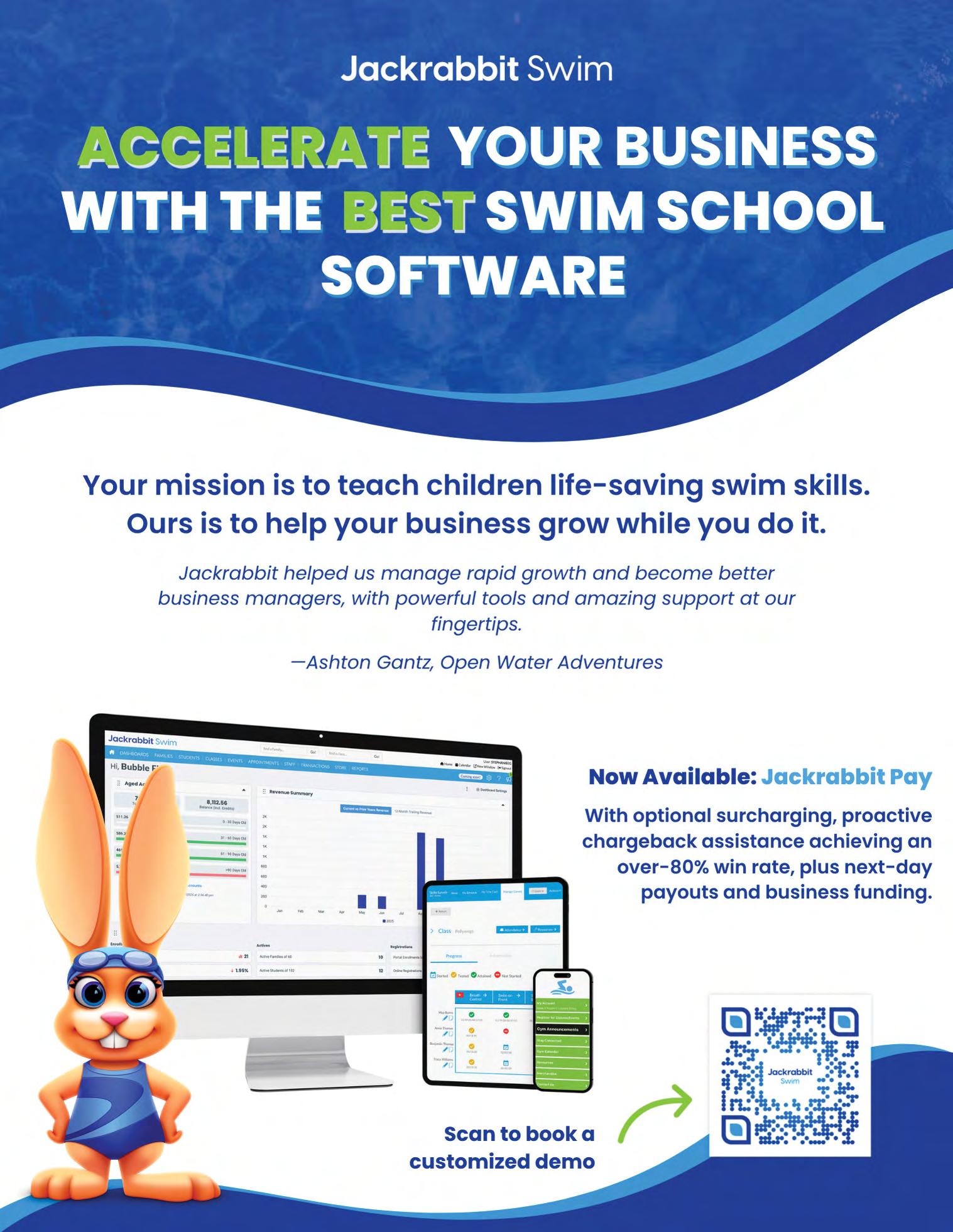

BY MOLLY STROUD JACKRABBIT TECHNOLOGIES
Youth activity centers play a pivotal role in helping children grow physically, emotionally, socially, and cognitively. As a result, swim, gymnastics and dance programs remain increasingly popular, and more and more parents seek such activities to enroll their children in.
Like any other business, youth activity centers rely on their customers to keep revenue flowing and stay afloat. Perhaps, one of the most important things you should know as a youth activity center owner or director is that building relationships and focusing on customer experience is critical to your success.
Continued on next page...

If your youth activity center is known for its authentic customer relationships, you’ll run circles around the competition when it comes to enrolling new students.
So, how do you foster relationships with new customers at your swim school, gymnastics gym or dance studio?
• Start first by getting to know your client
• Make sure you communicate frequently
• Strive to exceed your customers’ expectations
• Ask for feedback and make good use of it
If you want to know more about how to build relationships with new customers at your youth activity center, keep reading! Or skip to the section that your business needs to focus on to help build relationships with new students and families.
Now, more than ever, parents want to enroll their children in programs that have a great curriculum and are authentic. Skills matter, but don’t forget that 90 percent of customers say that authenticity is important when deciding which brands they like and support.
What does this mean to you?
It means that you need to dig deeper than just below the surface to get to know your students and parents. Being aware of customers won’t cut it anymore.
Whether you’re starting a new season, or a family just moved to town and wants to enroll their Brady Bunch-sized crew in classes mid-season, you must make an effort to understand each new customer’s needs and preferences. Then, personalize your interactions with each customer and show them that they are not just another number on your family roster.
Building relationships takes time, and it starts with getting to know them.
Your customer doesn’t care how much you know until they know how much you care.
Remember this. Getting to know new students is crucial, but you should not just make the initial effort and call it a day. Relationships need constant investment to stay healthy and grow. So, make it a habit to communicate with customers at your youth activity center frequently. Ensure that you open up channels of frequent communication so you can connect with customers.
With today’s technology, keeping in touch is not something that should take too much of your time and energy. Use social media and monthly email newsletters to stay top of mind. Also, use software to send notifications, share important reminders while customers are in their parent portal or a series of welcome to the family emails.
Building effective relationships with new customers at your youth activity center requires communication. Sometimes it’s easier to communicate with customers as a group. However, make your communication more personal and reach out for one-to-one interactions when you can.
If you want to know how to build relationships with new families, you need to meet and surpass their expectations.
Provide exceptional customer service from the jump by allowing families to register and pay for classes at your youth activity center anytime, anywhere. Take it one step further by making the process a one-stop-shop and you’re as good as gold.
Filling out forms, signing waivers and handling endless paperwork will do little to impress new customers. Discover how to streamline tasks, stay organized and impress new customers with Jackrabbit Class.

When you first meet new families, be open about what your expectations are of them. From pricing and payment schedules to working with instructors and expected class behavior, relationships with prospective customers will flourish if they know you’ll exceed their expectations and that they can live up to yours.
Your customers’ perception is your reality. Read that again. Your customers’ perception is your reality.
That’s why the last point in this article is to encourage you to ask for your customer’s feedback and carefully consider what they have to say.
• Is there something that your clients consistently complain about?
• Is there a suggestion that you could adopt to make their time at your swim school, gym or studio more enjoyable?
Find out what you are doing well and what you can do better, then use that knowledge to help influence the way you approach new relationships with students and families at your youth activity center.
Remember that there is always room for improvement. No matter how many excellent reviews your business has, there is bound to be something that warrants improvement.
Chances are you can’t see the thing or things that need to be improved. That’s why asking for customers’ open and honest feedback is in your best interest. After all, their perception is the one that matters. So, make their perception your reality.
Businesses rely on their customers to stay afloat. Nothing could be more certain for youth activity centers. Swim schools, gymnastics gyms and dance studios should not only offer excellent programs that build strong students, they should invest in building strong customer relationships, too. If you have an excellent program in place but are coming up short in the relationship department, you’ll begin to notice a strain in student retention or hear crickets from customers who were once interested in joining your program.
Instead, invest in ways to promote effective relationships with new and existing clients. If your clients are happy, they will bring in more customers. There is no better marketing than a customer who feels valued, appreciated, and enjoys a strong relationship with the business owner.
How can class management software help you foster relationships with new and returning students at your youth activity center? Take a customized tour of Jackrabbit’s communication tools and discover features that help make customers’ lives easier.

FOR MORE DETAILS, VISIT: USSWIMSCHOOLS.ORG/EVENTS
NOV 5
HOW I BUILT MY POOL VIRTUAL SERIES 2025 – PART 1: FINANCING AND LOANS VIRTUAL
NOV 7
HOW I BUILT MY POOL VIRTUAL SERIES 2025 –PART 2: ARCHITECTS, CONSTRUCTION & ZONING VIRTUAL
NOV 11
HOW I BUILT MY POOL VIRTUAL SERIES 2025 – PART 3: SETBACKS & CHANGE ORDERS VIRTUAL
NOV 13
HOW I BUILT MY POOL VIRTUAL SERIES 2025 –PART 4: OPERATIONAL PLANNING & LAUNCH VIRTUAL
DEC 1
CREATING NEXT LEVEL BABY TEACHERS
WORKSHOP – PART 1 VIRTUAL
DEC 8
CREATING NEXT LEVEL BABY TEACHERS WORKSHOP – PART 2 VIRTUAL
DEC 11
2025 HUMAN RESOURCES VIRTUAL SEMINAR VIRTUAL
DEC 15
CREATING NEXT LEVEL BABY TEACHERS
WORKSHOP – PART 3 VIRTUAL
FEB 19 – 20
2026 SPRING WORKSHOP THE BROADMOOR COLORADO SPRINGS, CO





A3 PERFORMANCE
AQUAMENTOR
BYLINE BANK
COMMERCIAL ENERGY SPECIALISTS (CES)
COUNSILMAN-HUNSAKER
CRESSI SWIM
GREEN SPROUTS


NEPTUNE
SBR
SPORTSENGINE MOTION
VORGEE USA
3rd Level | p44
A3 Kids | p14
Aqua Mentor | p18
Byline bank | p47
Career Plug | p6
CES | p31
Counsilman-Hunsaker | p9
Cressi | p4
EOS | p40
FINIS | p12
Green Sprouts | p27
iClass Pro | p2
IPU | p16
Jackrabbit Swim | p20
Neptune Benson | p19
Paddock | p15
Proven | p27
Risk Management | p24
Splash About | Inside Front Cover
Sports Engine Motion | p31
Starfish Aquatics Institute | p35
Swim Influx | p38
Tri Swim | p43
Vorgee | p43
Worldwide Swim | p42

We are excited to celebrate the achievements of those who have recently become Certified Fundamental Swim Instructors! Passing the CFSI exam is a significant accomplishment, reflecting your expertise and dedication as swim instruction professionals. We are proud to have you in our community and look forward to your continued contributions and commitment to excellence in swim education!
PAIGE BAKER
Nitro Swimming Bee Cave, TX
CHANIKA DARRELL
Water Lilies Bermuda Sandys, Bermuda
JONAH DIAZ
Nitro Swimming Kyle, TX
JAZMINE DIMOND
Wisconsin Swim Academy Appleton, WI
TINA ELLISON
Swim Fanatics Colfax, NC
MARY FAULK
Lane College Jackson, TN
SOFIA FILIPPI
Nitro Swimming Bee Cave, TX
DAPHNE HANZAK
Nitro Swimming Kyle, TX
VERONICA HERNANDEZ
Nitro Swimming Bee Cave, TX
NEVAEH HOWE
Nitro Swimming Kyle, TX
ALEXANDER HURD
Nitro Swimming Bee Cave, TX
ANDRE INGLES
Nitro Swimming Kyle, TX
KODY KIDDER
Nitro Swimming Kyle, TX
EDEN KNUFF
Nitro Swimming Bee Cave, TX
LACY LERIBEUS
Nitro Swimming Kyle, TX
ZOE MABIE
Nitro Swimming Kyle, TX
ALISON MILLICAN
Nitro Swimming Kyle, TX
MELISSA SAENZ
Nitro Swimming Kyle, TX
REEVE SANCHEZ
Nitro Swimming Kyle, TX
EMERY SCHMIDT
Nitro Swimming Bee Cave, TX
NOAH UNDERWOOD
River City Swim Academy Cape Girardeau, MO
JACOB ZAMORA
Nitro Swimming Kyle, TX




One of the simplest and most powerful ways to build a people-first culture is also one of the most overlooked: consistently catching people doing things right. Too often, leaders focus their attention on mistakes, shortfalls, and missed targets. While accountability is critical, it is equally important to reinforce positive behaviors and recognize contributions when they happen.
When leaders make a habit of looking for what is going well and calling it out, they create a culture where people feel valued and engaged. Recognition fuels morale, drives performance, and reinforces the behaviors that lead to long-term success. Leaders must avoid hollow praise and instead be intentional in noticing and celebrating actions that align with the organization’s values and goals.
BY JOHN SPENCE JOHNSPENCE.COM
Senior executives are constantly balancing strategic, financial, and growth priorities. In that complexity, it is easy to assume that recognition belongs in the domain of HR or front-line managers. But the culture of an organization is shaped most powerfully by what leaders consistently reward and reinforce.
The research is clear:
• Organizations with high-recognition cultures see significantly lower turnover, higher employee engagement, and stronger customer satisfaction.
• Employees who feel recognized are more likely to go above and beyond and solve problems proactively.
• Cultures that emphasize positive reinforcement are more resilient during times of stress and change.
Recognition, when practiced consistently, is not “soft” leadership. It is a high-ROI discipline that directly influences performance and retention.
A people-first culture is not defined by being “nice” or avoiding tough conversations. It is about creating an environment where individuals know they matter and their contributions connect to something larger.
Leaders in people-first organizations:
• Recognize daily wins: They don’t wait for the annual review or the big presentation. They look for small, meaningful moments where people demonstrate excellence.
• Make it specific: Instead of generic praise, they call out what was done well and why it matters.
• Tie recognition to values: They link the recognition back to the company’s mission, values, or strategic goals.
• Model consistency: They do it often, across levels of the organization.
This creates a reinforcing loop. Recognition builds morale. Morale drives engagement. Engagement sustains performance.
Despite its simplicity, many leaders struggle to consistently practice recognition. Here are the most common barriers:
Time pressure
Executives are pressed for time and feel recognition is something they will “get to later.” The solution is to embed recognition into existing routines, such as team meetings or one-on-ones.
Fear of favoritism
Some leaders worry that frequent recognition could be perceived as playing favorites. The key is to ensure recognition is based on clear, objective behaviors that align with shared values and goals.
Discomfort with praise
Not every leader finds it natural to give recognition. That is why specificity matters. Instead of generic praise, focus on observable actions. This shifts recognition from personality-based compliments to behavior-based reinforcement.
Overemphasis on problems
In many organizations, the leadership mindset is oriented toward fixing what is broken. While accountability is essential, a balanced culture pays equal attention to what is working well.
To make recognition a strategic habit, I recommend five practical steps:
1. Set the intention
Decide that part of your role as a leader is to actively look for moments worth recognizing. This mental shift alone changes how you observe your teams.
2. Create a daily practice
Challenge yourself to recognize several people every day. This could be as simple as sending a quick message, giving a shout-out in a meeting, or stopping by someone’s desk.
3. Be specific and sincere
Tie the recognition to an action or outcome. Avoid vague praise. The more concrete the recognition, the more meaningful it is.
4. Go public when appropriate
Recognition has even more impact when shared in front of peers, whether in a team meeting or through company-wide communication. Just be sure to match the recognition to the individual’s comfort level.
5. Model it from the top
When senior leaders consistently practice recognition, it signals that the culture values people and their contributions. This cascades through the organization and becomes a cultural norm.
As leaders, we often underestimate how much a simple word of recognition can matter. What feels like a small gesture to us may carry enormous weight for someone else’s motivation or loyalty to the organization.
In my work with executives, I have seen cultures shift when recognition becomes habitual. No new platforms. No budget. Just leaders deciding to watch for what is working and call it out when it happens. Culture is shaped less by grand initiatives than by repeated micro-behaviors. When leaders decide to notice and encourage growth, they change the signal the organization sends to its people. The questions for you are: when was the last time you caught someone doing something right? And who will you recognize today?
DESIGNED TO PROVIDE FRESH INSIGHTS AND BEST PRACTICES FROM EXPERTS IN THE LEARN-TO-SWIM INDUSTRY. WHETHER HR IS YOUR MAIN FOCUS OR ONE OF MANY HATS YOU WEAR, THIS SEMINAR OFFERS VALUABLE TOOLS, NETWORKING OPPORTUNITIES, AND PRACTICAL STRATEGIES TO STRENGTHEN YOUR HR SKILLS. DON’T MISS THIS CHANCE TO GROW AND CONNECT!
Registration: $135 for first log-in, $50 for each additional log in.
Joanna Enriquez - Juarez, Aqua-Tots Swim Schools
11th, 2025
DECEMBER 8 AM - 11:45 AM PACIFIC
Recruiting is not just about how to get applicants and doing interviews, there is so much more! Let’s look at what a good recruiting cycle looks like to keep employees in a high turnover industry. Also discussing practices you can implement to not only hire a good employee, but also keep them!
Leighann Day, North Jersey Aquatics
Running a business leaves little time to master HR — but getting it right makes all the difference. In this session, we’ll walk through the full employee lifecycle, from hiring and onboarding to performance management, PIPs, and even terminations. You’ll leave with practical, time-saving hacks to simplify HR, avoid headaches, and keep your team thriving.
Belinda Perry, Watermelon Swim School
Keeping great people isn’t just about surface-level perks—it’s about building a culture where they want to stay. I’ll share the simple, intentional things we do to keep the team engaged and growing with us: thoughtful onboarding, clear growth paths, recognition, regular check-ins, and company events that actually mean something. Whether you’re looking to strengthen your own retention efforts or simply spark some fresh ideas, this presentation will offer an honest, culture-first look at what’s working for us—and why it matters more than ever.
8:00 - 9:00 AM 9:05 - 10:00 AM 10:10 - 11:10 AM 11:10 - 11:40 AM
Take an opportunity to network with like-minded individuals! This engaging and informative discussion will be an opportunity to unpack all that you have learned up to this point. Share your experiences and learn from others in our roundtable discussions led by today's speakers.



Proven swim school treatment systems since 1983 including:
UV • Saline • Ozone • Chemistry Controls • Drinking Water-Grade ltration
Wirelessly control your pump room including chemistry, UV, Heaters.
Choice of leading USSSA Swim Schools!
Proven On-Site Support and Service throughout the US via the SSD™ Network.
Experts in new construction and renovation treatment programs.

Commercial Energy Specialists • 952 Jupiter Park Lane • Jupiter, Florida 33458 • 800.940.1557 • www ceswaterquality com


When I interviewed for my last job, before starting Candid Culture 19 years ago, the CEO put a mug in front of me with the company’s values on it and asked if I could live by those values at work. He was smart. Hiring someone with the skills to do a job is one thing. Hiring someone who fits into the organizational culture, is another.
Determining if a prospective employee will fit your organizational culture is much harder than determining if someone has the skills to do a job. Often when an employee leaves a job, only to take the same role at another company, they left for fit. They just didn’t feel comfortable. They weren’t a good fit with the organizational culture. You’ve probably heard discussions about employees who deliver results at the expense of relationships. Or about employees who fellow employees really like, but they just can’t do the job.
Leaders of organizations need to decide what’s important: What people do? How they do it? Or both. I’m going to assert that both the work employees deliver and how they deliver that work is equally important. I think you should hire and fire for fit.
Work hard to hire people who will fit into your organizational culture. Get rid of people who don’t fit. The impact on your organization’s reputation and on internal and external relationships depends on hiring people who behave consistently with your brand and how you want your organization’s culture to feel.
At Candid Culture, we teach people to have open, candid, trusting relationships at work. Thus, we must hire people who are open to feedback and communicate honestly, and we tell people who don’t model those behaviors to find a better fit
HERE
1. Share your current or desired culture with job candidates early, often, and clearly.
2. Work to assess how candidates fit the culture. Use practical interviews, job shadowing, and reference checks to assess organizational culture fit.
3. Talk about the culture when onboarding employees.
4. Make behaving according to the culture part of your performance appraisal process.
5. Reward behavior that matches the culture.
6. Have consequences for not acting according to the culture. A negative feedback conversation is a consequence.
7. Ensure your leaders and managers live the culture. Eliminate leaders and managers who aren’t a good culture fit. This takes courage.
BY SHARI HARLEY CANDID CULTURE
When people leave an organization, they don’t often take copies of reports they produced or work they created. And if they do, they rarely look at that work. What they do take, remember for years to come, and find meaning in, are the relationships they built at work. Relationships are dependent on organizational culture.
Determine the organizational culture you want. Talk about it regularly. Require people to act according to the culture. Reward the ones who do. Get rid of the ones who don’t. Make working in your organization feel as you want it to feel.
Shari is the founder and President of Candid Culture, a Denver-based training and keynote speaking firm that is bringing candid conversations back to the workplace, making it easier to tell the truth at work. Shari is the author of the business communication book How to Say Anything to Anyone: A Guide to Building Business Relationships that Really Work. Learn more about Shari Harley and Candid Culture’s training programs at www. candidculture.com.

• Greet every parent with eye contact and a smile.
• Acknowledge concerns before offering solutions.
• Keep tone calm and steady, even when you’re busy.
• End every interaction with gratitude (“Thanks for bringing that up!”).
• Follow up when you say you will –it builds lasting trust.
INSTEAD OF:
“That’s our policy.”
TRY:
“Here’s why we do it that way: it helps keep lessons consistent for every swimmer.”
INSTEAD OF:
“I don’t know.”
TRY:
“That’s a great question! Let me double-check so I can give you the best answer.”
INSTEAD OF:
“We can’t.”
TRY:
“Here’s what we can do to help.”
In every conversation - at the front desk, on deck, or over emailyour words carry more than information. They carry your brand. Professionalism in a swim school isn’t just about knowing what to say, it’s about how you say it. Families notice tone, timing, and body language long before they register the message itself.
1. START WITH PRESENCE
Professional communication begins before you even speak. Eye contact, a smile, and a calm tone tell families they’re in capable hands. Whether you’re greeting a new swimmer or answering a parent’s question, how you show up communicates confidence and care.
“People may forget what you said, but they’ll remember how you made them feel.” Maya Angelou
2. KEEP MESSAGES CLEAR AND CONSISTENT
Mixed messages create confusion, and confusion erodes trust. Align your team around shared language, especially for common topics like make-ups, weather policies, and student progress. When every team member communicates with consistency, families experience unity and professionalism.
3. LISTEN TO UNDERSTAND, NOT JUST RESPOND
When a parent raises a concern, professionalism means listening without defensiveness. A simple pause, followed by “I hear what you’re saying,” can shift tension into trust. It shows respect and genuine care, even before a solution is offered.
4. MATCH YOUR MEDIUM TO THE MOMENT
Not every message belongs in an email. Sensitive or emotional topics are best handled in person or by phone, where tone can carry empathy. Quick confirmations or reminders, on the other hand, work well through written communication. Choose your medium with the same thoughtfulness as your words.
5. MODEL COMMUNICATION FOR YOUR TEAM
Professionalism trickles down. When leaders communicate with warmth, clarity, and consistency, staff follow suit. Encourage your team to role-play parent conversations or share real examples of strong communication moments.
Professionalism isn’t about perfect wording – it’s about connection, clarity, and care. Every email, phone call, and poolside chat shapes how families experience your school. When communication reflects your values, professionalism isn’t just heard –it’s felt.


“At Ocaquatics, we see swim lessons as the starting point—not the finish line. Teaching kids to be safer around the water is lifesaving work, but what makes it even more meaningful is how our team members grow through the process.
We’re big believers in always learning and it’s actually one of our core values. Many of our team members are in their first job or early in their careers, so we focus on helping them build skills they’ll use for the rest of their lives. That includes leadership, communication, financial literacy, emotional intelligence, and learning how to be part of a high-functioning team.
We talk a lot about owning it, owning your role, your attitude, your growth. And we try to model that from the top down. We’re not just training people to be better swim instructors. We’re helping them become better humans.
Sometimes people ask, “But what if you train someone and they leave?” And my answer is always: “What if you don’t train them and they stay?” That’s way more scary! The goal is to help people get better every day, and if we do that right, some of them will stay and grow into leaders and others will go out into the world and do amazing things. Either way, we’ve done our job.
It’s not about perfection. It’s about progress. If you create a culture where people know it’s safe to learn, grow, and make mistakes, they’ll show up more fully. And that’s when the real magic happens, not just in the pool, but in the lives of everyone on the team.”
MIREN OCA FOUNDER & CEO, OCAQUATICS SWIM SCHOOL
“Helping our team move beyond just teaching swim lessons really comes down to helping them see the bigger picture — our impact….what we do is so much more than swimming! We’re building confidence, shaping character, helping brains grow, and….. bonus, we are teaching a life-saving skill that stays with kids forever!
We talk a lot about our “why” and our values. When our instructors understand the purpose behind what they do, they start to see themselves as professionals — not part-timers or lesson-givers, but people who show up and make a real difference.
We also invest in them. In addition to sharing our growth path, we consistently create weekly mini learning opportunities for instructors to grow both personally and professionally, with an emphasis on impact. Our pre-shift meetings aren’t just about logistics/student details— they’re about improving teaching, building leadership skills (we emphasize that everyone is a leader), and reinforcing our core values.”
CARRIE DEMONT OWNER, DEMONT FAMILY SWIM SCHOOL
“We emphasize the importance of the role of a swim instructor. Teaching is a profession. Teachers are professionals. Teaching swim lessons is a very important job that has major impact. Recognize the importance of the role. Talk about your mission – your Why – tie it into the role of a swim instructor. Find people with passion for working with children and want to be with them, see the “lightbulb” moments. Share stories from parents about how the child is doing at home, how they fell in and swam to the wall, how they had the best child at the neighborhood swim party, how at a hotel on vacation people couldn’t believe their child’s ability. Honor them – Celebrate their annual anniversaries. Congratulate the long term – tenured instructors. Give awards – Teacher of the year. Safety instructor of the year. Rookie of the year. If you give swimmers ribbons–give you instructor a ribbon – an awesome ribbon. Recognize them. Your instructors are the delivers of the product! They are key components of your company – make sure they feel it! Never say – “just an instructor!” Make sure they know you see the importance of their role.
If you have swim instructors who want to become managers – that is wonderful – you can lead them into other roles, we always have them still teach. Even our GMs teach. Teaching is that important.”
ANN MARIE SUNDERHAUS
COO, HUBBARD FAMILY SWIM SCHOOL
ALTAVISTA AREA YMCA
Elizabeth Wilson Altavista, VA
AQUA BABY SURVIVAL
SWIM SCHOOL
Nicole Nusshag Vail, AZ
AQUA GLIDERS A SWIM SCHOOL
Christina Romney Gilroy, CA
AQUAKINETICS
SWIMMING INSTRUCTION
Peter Teeple Spokane, WA
ARBITOTS MONTESSORI
MONTESSORI SWIM
Angelica Turingan-Jo Fremont, CA
COSMIC AIR SWIM SCHOOL
Shawn Meghani Richmond, TX
GOLD MEDAL SWIM ACADEMY
Aaron Opell Newburgh, IN
JUMP SWIM SCHOOLS
Virginia Bullock Bossier City, LA
RALEIGH SWIM SCHOOL
Ekaterina Khalimon Cary, NC
RIVER CITY SWIM ACADEMY
Noah Underwood Cape Girardeau, MO
SCUBA STEVE’S SWIM SCHOOL
Steve Renie Lafayette, IN
SEAHORSE SWIM SCHOOL, INC.
Tiffany Harmon Aptos, CA
STREAMLINE SWIM ACADEMY
Elaena Noffsinger Janesville, WI
SURGE SWIM SCHOOL
Derek Howorth New Braunfels, TX
SWIM FANATICS
Anitra Fulton Colfax, NC
SWIMGYM
Mario Santos Hermosillo, Mexico
SWIMMING WITH JOJO
Joanne Baumgardner Lubbock, TX
SWIMWTIHCAROL
Carol Mathus Dallas, TX
WATER LILIES BERMUDA
Fiona Nusum Sandys, Bermuda


Swim Influx 2.0 was built specifically for swim schools offering a fully integrated marketing system that supports every stage of the customer journey utilizing A.I. & Automation. From generating high-quality leads to converting them into loyal clients, we help you streamline your growth by handling the marketing for you. Our team of specialists becomes an extension of yours so you can stay focused on teaching while we focus on filling your schedule.
Targeted Customer Acquisitio paid ads

Google Review Growth to boost local visibility & trust
Referral Engine that turns happy customers into promoters
Social Media Management & Optimization to build brand awareness
Automated SMS & Email Campaigns for lead nurturing & retention
A.I.-Powered Chat Widget to engage and convert website visitors 24/7
High-Converting Websites built to drive action and bookings
M o r e C l i e n t s . M o r e R e v i e w s . M o r e R e v e n u e

In 2025, Swim Influx helped 115+ swim schools generate more than 136,000 leads proven results, not promises.



Colorado springs, co feb 19 - 20 , 2026
Experience the iconic Broadmoor Resort in Colorado Springs! A five-star destination surrounded by mountain views
Exclusive hotel rate: $175 per night for a luxurious room and accommodations
Designed for everyone in your swim school owners, managers, and instructors alike
In-Water Sessions to refine and elevate your teaching techniques hands on

Actionable insights on swim instruction, business growth, customer service, and more Engaging sessions led by respected industry leaders
Collaborative learning that sparks ideas and solutions you can implement right away
Valuable networking with peers who share your goals and challenges

Meet and connect with sponsors offering innovative tools, technology, and resources to support your success
Hotel Room Block is OPEN and WILL SELL OUT!
*Under the Aquatic Professionals room block.





Even the savviest business owners can't do it all on their own. Gaining Traction® requires a team of people who have a clear understanding of what your vision is, and how to achieve it. Mary Reilly-Magee has over 20 years of experience owning her own swim school business and has been running on EOS since 2017, so she knows exactly how to match the right people together to build effective teams. She's spent years building relationships, being coached and coaching others. She can teach you how to get on the fast track to building an even better business now.
• 30-minute one-on-one conversation
• A s safe, judgment-free space to talk about your business
• Experience shares and personalized resources
• A trusted referral resource with access to great implementers at all price ranges
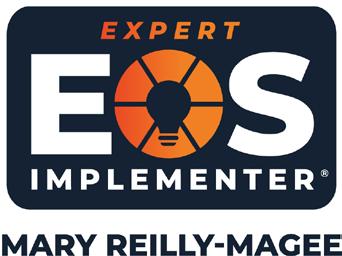
• Annoying, salesy jargon
• Pressure to work with someone who's not right for you
• Untested business theory
BY MARY REILLY-MAGEE

Professionalism isn’t about being rigid or outdated, it’s about being intentional. It’s the set of quiet signals we send every day, often without realizing it, that tell others who we are, how we lead, and what we value.
Whether you’re a new professional or a seasoned leader, the fundamentals haven’t changed. How you show up matters. It shapes how people trust you, how opportunities find you, and how you influence those around you.
In an age of constant communication, one of the simplest yet most powerful acts of professionalism is responsiveness. When someone shares a resource, a document, or a playbook meant to support your success, acknowledge it. A quick “Thank you” or “Got it” goes a long way. Silence, on the other hand, leaves a lot of room for a made up story that you aren’t appreciative or respectful. Is that what you intend to communicate? I bet it’s not.
Professional courtesy costs nothing but speaks volumes. It tells people you respect their time, value collaboration, and understand that relationships are built on mutual regard. It tells others that you are worth investing in.
Continued on next page...
Every interaction, digital or in person, communicates something. From your body language to your wardrobe, people are drawing conclusions the same way you do about others.
“ Dress for the job you want, not the one you have” isn’t an empty saying.
When you take pride in how you present yourself, you not only influence how others perceive you, but also how you perceive yourself. Standing tall, making eye contact, and showing up prepared are small choices that build both internal confidence and external credibility.
Everything communicates.
The giant wad of gum in your mouth while talking to a customer, makeup left over from last night, or clothing that’s a bit wrinkly or overdue for a wash—all of it sends a message. The question is: Is it the message you intend to send?
It’s true that we should all feel free to express ourselves, and that judgment has no place in a healthy workplace, but self-expression and self-awareness go hand in hand. You are always attracting something whether that is attention, trust, respect, or distraction.
How often do you stop to think: What do you want to attract?
Being intentional about your words, tone, and appearance doesn’t mean conforming, it means understanding your impact. You can be fully yourself and still show the awareness that elevates you as a professional and a leader.
What you look like, how you speak, how you respond, the energy you bring— all of it matters. These aren’t superficial details; they’re part of how you communicate reliability, care, and leadership. The goal isn’t perfection, it’s presence with a purpose.
Before your next meeting, ask yourself:
• How am I showing up today?
• What am I communicating through my presence, my words, and my attention?
• Am I setting the tone I’d want others to follow?
Small acts of courtesy and self-awareness might seem minor, but they add up. They define your reputation. They shape your influence. Professionalism isn’t about being polished for appearance’s sake, it’s about being intentional in how you move through the world.
And ultimately, they’re what distinguish good leaders from great ones.
Seeing what love can do, Mary Reilly-Magee
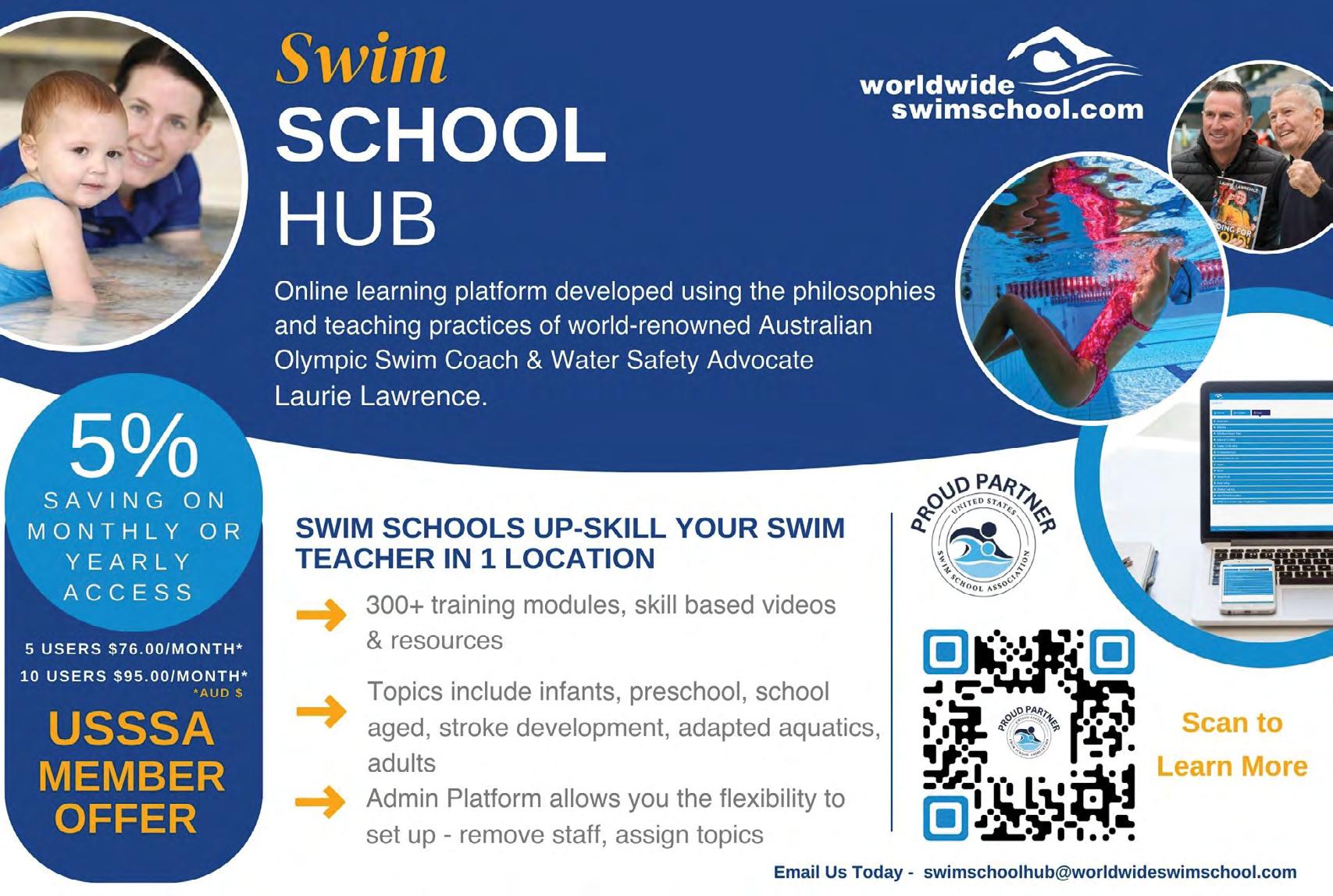






In a swim school, professionalism isn’t a policy it’s a practice. It shows up in the way your team communicates, prepares, and responds. Families notice it long before they ever read your handbook or see your credentials. The good news? You don’t need a complete overhaul to raise your standard. A few intentional habits can transform the way swimmers and parents experience your program.
Take 15 minutes in your next staff meeting to outline what professionalism means in your swim school. Ask: What behaviors reflect respect and care? How do we want parents to describe us? What actions make people instantly trust our brand?
When your team helps define the standard,they’ll take ownership of it.
Missteps often happen because expectations were never made clear. Create short guides or role-plays for:
Parent greetings and class intros
Phone and email responses
Handling nervous swimmers
Consistency builds confidence –inside and outside the pool.
Step into your school as if you were a parent seeing it for the first time. What stands out? What could be improved? Or better yet, invite someone unfamiliar with your school to experience it as a first-time visitor. Encourage them to share what they see, hear, and feel along the way. Those outsider impressions often highlight small details—tone, flow, or visual clutter— that your team might miss.
Don’t wait for issues to arise.
Use quick, positive feedback to reinforce expectations:
“I love how you stayed calm with that nervous swimmer.”
“Let’s double-check uniforms before tonight’s classes.”
Frequent micro-feedback keeps everyone aligned and motivated
Celebrate the moments that represent your standard of excellence. Spotlight an instructor who handled a tough class with grace or a front-desk teammate who communicated clearly under pressure. Recognition turns good habits into everyday norms.
When your team acts with intention, families can feel it. Professionalism is built in everyday moments: the warm greetings, the follow-ups, the way challenges are handled with calm confidence. Those small, consistent actions are what make your swim school stand out for all the right reasons.
• Refresh email templates for warmth and clarity
• Do a uniform & appearance check before shifts
• Create a “first-impression checklist” for new hires
• Add a one-minute communication tip to staff meetings
• Give positive feedback to 3 staff members every day
• Warm greeting at check-in
• Smooth class transitions
• Clean, organized viewing and locker areas
• Calm, confident energy on deck
• Clear, kind communication
• Instructors who look prepared and engaged


Professionalism isn’t just about appearances it’s about the consistent practices that keep a school running at its best. For this issue, we asked our Board of Directors to share the one habit or system that has given them the biggest professional edge in running a high-performing swim school.
What one habit or system has given you the biggest professional edge in running a high-performing swim school?
THE BEST INVESTMENT WE HAVE MADE HAS BEEN INVESTING IN MY TEAM BY WAY OF EOS. BY EMBRACING EOS AND ITS SIMPLICITY AND CLARITY ALLOWS US TO CREATE THE TEAM CULTURE THAT HELPS US DO GREAT WORK.
ROSE CHOLEWINSKI SWIMAMERICA AND SWEET PEAS, DAVIS
The greatest professional edge in running a highperforming swim school has come from consistently investing in growth—both in myself and in my team.
Continuous education isn’t just a philosophy; it’s a system we’ve built into our culture. We attend conferences, host guest speakers, and encourage book studies and TED Talk discussions that challenge our thinking. We’ve also developed an in-house Manager in Training program to ensure our future leaders are equipped with the skills and mindset to succeed.
This commitment to learning not only strengthens our talent but also reinforces that each individual is valued, supported, and capable of continual growth. A culture that prioritizes education becomes one that naturally attracts excellence, accountability, and innovation.
MICHA
SEAL WATERMELON SWIM
FOR ME, PROFESSIONALISM IS ROOTED IN CONSISTENCY, BUT IT’S ELEVATED BY EMPATHY. WORKING IN A FRANCHISE SYSTEM, THE MOST POWERFUL HABIT I’VE DEVELOPED IS INTENTIONAL COMMUNICATION GROUNDED IN UNDERSTANDING THE PEOPLE BEHIND THE WORK.
Each week, I make time to truly connect with my team, franchise owners, and partners so we are able to align on goals and expectations. But beyond the systems and checklists, it’s about recognizing personality types, reading the room, and adjusting my approach so every person feels heard, valued, and supported. That human connection turns accountability into collaboration and makes professionalism feel personal, not procedural.
I’ve learned that empathy and consistency can coexist! Being reliable, clear, and composed, even in challenging moments helps to build trust and set the tone for how others show up as well.
Professionalism isn’t about being rigid; it’s about being intentional. It’s the balance of heart and structure and the ability to lead with both compassion and clarity so excellence becomes not just a standard, but a shared mindset.
MELISSA MCGARVEY
BRITISH SWIM SCHOOLS
Entrepreneurial Operating System (EOS) about 5.5 years ago has given me the biggest professional edge in running a high-performing swim school.
Before EOS, I experimented with several systems to align our values, vision, mission, and goals, but none created lasting traction. EOS changed that. It brought every level of the organization—from leadership to coaches—into alignment, rowing in the same direction and operating at a much higher level of productivity and performance. One of the most impactful aspects has been making sure we hire the right people and place them in roles that match their strengths on the accountability chart. As a result, we’ve built a strong, cohesive team that thrives under this system.
LORI KLATT
AMERICA’S
KIDS SWIM SCHOOL

WHEN PEOPLE ASK WHAT’S MADE OUR SWIM SCHOOL SUCCESSFUL, MY ANSWER IS SIMPLE: PROCESS AND REINVESTMENT. IT MIGHT NOT SOUND GLAMOROUS, BUT IT’S BEEN THE HEARTBEAT OF OUR GROWTH.
Early on, I realized that passion alone wouldn’t keep things running smoothly. We needed systems clear, intentional ways of doing things that everyone could follow. From how we welcome families at the front desk to how we celebrate a child moving up a level, everything has a process behind it. Those systems bring consistency, safety, and peace of mind to both our staff and our families.
But systems alone don’t create magic. Over the years, I’ve learned the importance of investing back into the business upgrading our facilities, supporting our instructors, and continually improving the customer experience. Every reinvestment, big or small, has strengthened our foundation.
And at the center of it all is people. Our customers, our instructors, our community. When you build processes that support people and then pour your energy right back into those same people growth and success are simply the natural outcome.
SUSIE VAN EKEREN
WISCONSIN SWIM ACADEMY
The habit that gives me the greatest professional edge in running a high-performing swim school is maintaining a culture of consistent communication and reflection within our team.
Short debrief meetups celebrate successes, review what’s working, identify small issues early, discuss challenges, and brainstorm improvements. These check-ins keep everyone aligned with our mission, building trust, accountability, and continuous growth among our team while reinforcing our shared goal—creating a safe, fun, joyful, and high-quality learning environment for every swimmer. Over time, this simple habit of prioritizing open communication, steady reflection, and adaptability keeps us motivated and deeply connected to the families we serve. It’s the steady rhythm that keeps our culture strong and our performance high.
DEBBIE SAYERS
DOLFUN SWIM ACADEMY
I feel the biggest professional edge for me has been creating systems that center on people, not paperwork.
At Bitty Bubbles, we believe consistency builds confidence, so everything from how we greet families to how we celebrate milestones has an intentional rhythm behind it. Those “small systems” create a big sense of trust, safety, and belonging. Over the years, I’ve also learned that growth comes from reinvesting not just in our space, but in our people. When you pour back into the team that pours so much into others, magic happens naturally.
BRITTANY MOOG
BITTY BUBBLES SWIM SCHOOL
FOR ME, THE BIGGEST PROFESSIONAL EDGE HAS COME FROM EMBRACING EOS WITH OUR STAFF.
Using tools like the Level 10 Meetings, Rocks, and the Accountability Chart has really elevated the professionalism of our team and, in turn, the Association. These systems give us clarity, consistency, and a shared language, which has helped us focus on what matters most. Most importantly, our staff has fully leaned into the process, and their commitment has raised the bar for all of us.
LISA ZARDA
USSSA


Keep growing year-round with USSSA’s online courses! Perfect for training and developing your team anytime, anywhere.
A professional credential that equips you with the knowledge and skills to deliver safe, effective, and engaging lessons wh ile setting the standard for excellence in water safety and foundational swi m instruction.
Bulk Pricing Avaialable!


Preschool instruction methods, science of swimming, early skills, safety, and purposeful play. Great for quickly training sea sonal or new staff.
Bulk Pricing Available!

Equips instructors of children 6–36 months to build comfort, confidence, and water success—without trauma. Follow-Up Workshop Available.

This course is designed to educate on how to instru ct ALL students to be successful by focusing on their abilities, while understanding their disabilities. Follow-Up Workshop Available.

Shows how age-appropriate play enhances learning, i nstructor engagement, and parent satisfaction.

Explores the link between movement and a child’s ph ysical, emotional, and cognitive growth.
Teaches balance, breath control, and gentle movemen t to build trust and a foundation for lifelong swimming skills. Learn More at: usswimschools.org/education/